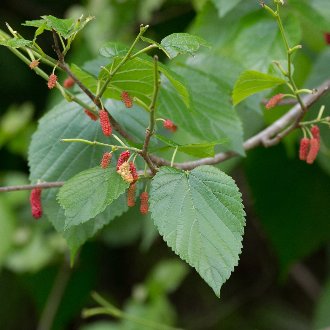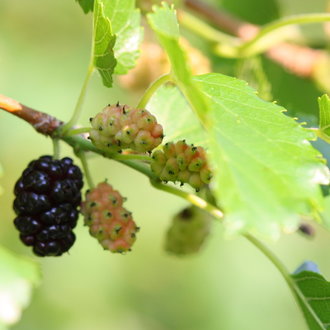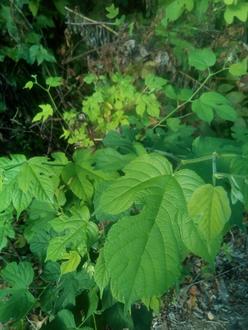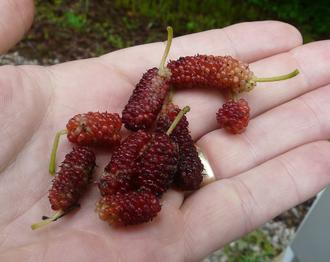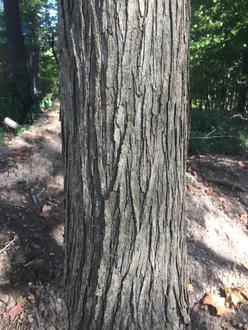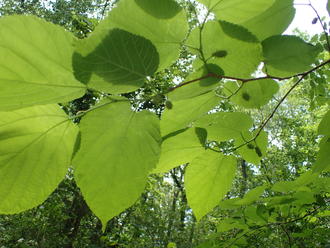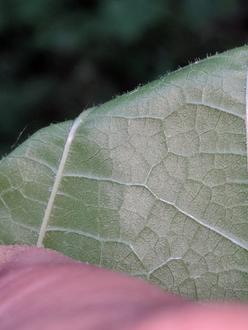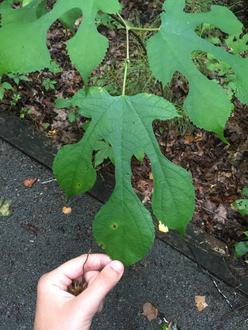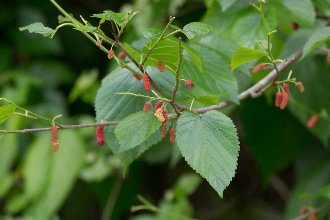Red Mulberry (Morus rubra L.)
↑Summary
A native tree of moist, mature forests in eastern North America, threatened by hybridization with the introduced white mulberry.
↑Range - Expand
| Legend | Color |
| Native | |
| Native or Not Present | |
| Native or Expanded | |
| Introduced | |
| Native or Introduced |
This tentative map is based on our own research. It may have limited data on Canada and/or Mexico, and there is some subjectivity in our assignment of plants as introduced vs. expanded. Read more in this blog post.
Although this plant occurs somewhere in each of these regions, it may only occur in a small part of some or all of them.
↑Similar Plants
↑Habitat
Found in mature, moist forests. Most frequent in forests of floodplains and sheltered coves, but occurs occasionally on a wide variety of sites. Grows on a variety of soil textures, including clay, sand, and loam, and found in both nutrient-rich and nutrient-poor soils, well-developed and poorly-developed soils, and soils with leached surface layers. Tolerates a wide range of pH.
Growth is best on well-drained but moist sites, but this species occurs occasionally on drier upland sites, as well as flood-prone sites. Mature trees can usually survive flooding by up to a foot of water for as long as one growing season but will die if flooded for two growing seasons.
Typically found in mid-to-late successional forests, but usually not an early colonizer of disturbed sites. Often appears first in forests when they reach about 80-90 years of age. Typically establishes by colonizing gaps in these forests as trees die, and persists indefinitely as the forest develops. This species has a low tolerance for habitat degradation and anthropogenic habitats, and is usually only found in intact wild areas.
Usually occurs only as scattered individuals, never in pure stands or as a dominant species.
Highly susceptible to fire and usually found in habitats that do not burn.
↑Life Cycle
This species is a short-lived, tree that tends to be medium-sized among trees in the habitats where it occurs.
Trees usually begin producing fruit around 10 years of age, but may occassionally produce small volumes of fruit as early as 4 years of age. Seed production usually peaks between 30 and 85 years of age and usually continues until the tree dies. Good crops are produced every 2-3 years. The maximum height of this species varies by site, typically between 25-60 feet, but in most habitats, it maxes out shorter than some of its associates.
Fruits fall to the ground when fully ripe, but birds frequently consume the fruit when not fully ripe. This leads the fruit to be consumed and distributed both by birds and by small ground-dwelling animals.
Plants will resprout if top-killed, and can also reproduce vegetatively by layering.
We found conflicting information about this species' lifespan, but it is generally agreed to be short-lived among hardwoods of its size. Some sources say it rarely lives more than 75 years, whereas others give maximum lifespans of 100 to 125 years; these longer estimates likely represent atypical individuals. Trees can be killed by shading if they are overtopped by more shade-tolerant species; they often succumb to disease when stressed.
↑Faunal Associations
Red mulberry fruits are eaten by a wide variety of birds and mammals, and have particular value to wildlife as they mature earlier in the year than most fruit, in early to mid summer, at a time when little other fruit is available.
↑Uses
The fruits are eaten fresh as well as being used in jam, jelly, and pies, although not usually commercially nowadays.
The wood, especially the heartwood, is very durable, resistant both to insect damage and to the elements, and it also has good workability. It is sometimes used for fenceposts where it is locally common, and also used for furniture and turned objects. However, due to this species' small size and scattered distribution, the wood is not usually harvested commercially, and is in low availability and tends to be high in price.
↑Related Plants
The introduced white mulberry (Morus alba), which is widely considered invasive, has established all across North America, and is much more common than red mulberry, especially in disturbed habitats and especially in the north part of this species range. It also ranges farther north and west. These two species form fertile hybrids readily, and thus form extensive integrades, and there is likely extensive gene flow between the two species where they interact. Many sources describe this hybridization process as "threatening" the red mulberry species, although it is not clear whether hybridization is causing any sort of decline or rather the decline has been driven primarily by habitat destruction, as red mulberry is late to move back into disturbed forests, whereas white mulberry thrives in disturbed habitats.
There are also other mulberry species found in North America, including the Texas mulberry (Morus microphylla) which overlaps with red mulberry in a small region of Texas, and the introduced black mulberry (Morus nigra) which is established in two parts of the red mulberry's range, in Louisiana and also in the area where Ohio, Kentucky, and West Virginia meet, as well as non-overlapping populations in the west.
In North America the next most closely related plant is the osage-orange (Maclura pomifera).
↑Links & External Resources
• Mulberry | The Wood Database (About This Site)
• Red Mulberry | Fire Effects Information System (FEIS) (About This Site)
• Morus rubra (Red Mulberry) | Illinois Wildflowers (About This Site)
• Morus rubra (Red Mulberry) | USDA PLANTS Database (About This Site)
• Morus rubra | Go Botany (About This Site)
• Morus rubra (Red Mulberry) | Missouri Botanical Garden Plant Finder (About This Site)
• Red Mulberry | Virginia Tech Dendrology Factsheets (About This Site)
• Red Mulberry | Silvics of North America (About This Site)
• Morus rubra | Biota of North America Project (BONAP) (About This Site)
• Morus rubra | NatureServe Explorer (About This Site)
• Morus rubra | Flora of North America (About This Site)
• Red Mulberry | Maryland Biodiversity Project (About This Site)
• Morus rubra L. (Red Mulberry) | Digital Atlas of the Virginia Flora (About This Site)



